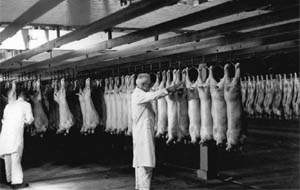
By Allan Barber
We could be forgiven for thinking nothing has changed in the last forty years with regard to meat schedule setting, if not actual price levels.
But an address to the Ruakura Farmers Conference in 1975 by then chairman of the New Zealand Meat Producers Board, Charles Hilgendorff, gives an interesting perspective on the industry at that time.
The Board’s overriding concern was price stabilisation whereby it sought to avoid excessive short term highs and lows, but it was not in favour of absolute stability because this would provide a misleading impression to producers. The Meat Board had been involved in price support for the past 20 years and, funded as it was by farmer levies, it saw the need to use levy funds to smooth prices within a range. When prices exceeded a certain trigger, the surplus would be withheld from producers to provide a buffer when prices dropped.
However a key criterion was the need for prices to reflect market realisations not income adequacy. It was the Government’s responsibility to ensure an adequate income for producers to be agreed with Federated Farmers after consultation with the producer boards. Minimum prices would be set before the start of each season reflecting market prices and the relativities between different products and grades.
In the event meat companies were unable or unprepared to pay a price at least as high as the season’s minimum, the Meat Board reserved the right to make supplementary payments or even to intervene in the market. This of course was at a time when producers were paid a subsidy on livestock on farm which would be removed just over 10 years later when David Lange formed a Labour government.
The Meat Board estimated the UK average price for lamb in 1976 would have to be 32 pence per pound to meet the Government’s minimum price of $7 per head, but noted the price had not exceeded 29p at any time in the past. There was no mention of the average price of prime, but an average CIF New York price of US$0.82 for manufacturing cow was necessary to underpin the guaranteed minimum of 40 cents a kilo compared with the current season’s price of US$0.55 in the USA and less in other markets.
Sectors have to cope with business conditions at any particular time, but with hindsight it is hard to see how either farmers or taxpayers were able to sustain the situation forty years ago. Farmers were being guaranteed subsistence prices for their production and the Government was applying an enormous amount of the tax take to paying subsidies to agricultural producers. [And taxpayers were also underpinning employment by soaking up unskilled labour into both the Post Office and the Railways at the same time. Ed]
It is small wonder this all had to come to an end, as it did 10 years later. It is amazing this system lasted as long as it did.
It is also worth reflecting on just how far the agricultural sector has come since then, even if we have not moved as far up the value chain as is necessary for the future prosperity of farmers, businesses servicing the agricultural market and the economy as a whole.
To subscribe to our weekly Rural email, enter your email address here.
Farms For Sale: the most up-to-date and comprehensive listing of working farms in New Zealand, here »
Here are some links for updated prices for
- lamb
- beef
- deer
- wool
Y Lamb
Select chart tabs
-----------------------------
Allan Barber is a commentator on agribusiness, especially the meat industry, and lives in the Matakana Wine Country. He is chairman of the Warkworth A&P Show Committee. You can contact him by email at allan@barberstrategic.co.nz or read his blog here ».
8 Comments
Just had a great roast of Californian Angus beef. Price, $2.99 a lb. Cost me $12 to feed a family of 6 with plenty left over. I wasn't on special either.
and in NZ they charge like a wounded bull...oopsie
;]
Seriously just how the F are we meant to be competitive at that price?
Well you know how determined the red meat industry were to get their own fonterra...
cheapest ground beef, $12.99 per kilo (15.99 at the new world).
electricity to store it also more than californiA prices.
they don't have as many officials to certify it, so it can't be as good.
and to think "you'd never starve in NZ", it's the country of milk and honey, cheap agricultural is our thing.
At least we can get about $3kg for a dairy cow on the hooks
NZ ground beef at Costco is around the $3 US a lb. $2.96 lb from memory.
I wonder what that is in NZD... apparently I'm not the only one unimpressed with Fonterra - their sharewprice dropped and the NZD:USD took a nose dive (in the past its barely moved).
What' has held the price up here is local trade. Dairy farming has dropped our numbers of prime cattle.
But what was total farm debt then
http://www.stuff.co.nz/business/farming/agribusiness/68931144/John-Key-…
A bit difficult to believe this story that you would pay someone a settlement without securing any document to protect against the" claimed" lawsuit.

We welcome your comments below. If you are not already registered, please register to comment.
Remember we welcome robust, respectful and insightful debate. We don't welcome abusive or defamatory comments and will de-register those repeatedly making such comments. Our current comment policy is here.